The Impact of Leadership on Compassion and Caring in Nursing Teams
VerifiedAdded on 2020/09/17
|12
|4302
|78
Report
AI Summary
This report examines the critical role of effective leadership in fostering a culture of compassion and care within clinical nursing teams. The introduction defines leadership and its significance in healthcare, emphasizing the leader's role in guiding, inspiring, and managing teams to provide safe and effective care. The report utilizes the Gibbs reflective model, exploring leadership theories, particularly in the context of health policy, and highlights the importance of developing compassion and caring in nursing. It delves into various leadership styles, including bureaucratic, charismatic, servant, and transactional approaches, and discusses how effective leadership can inspire and develop clinical teams. The report emphasizes the leader's responsibility in creating a positive environment, understanding team members, and ensuring patient safety, while also addressing the development of a culture of compassion through maintaining good relationships, providing high-quality service, and implementing supportive human resources policies. The report concludes by stressing the importance of training and guiding team members to enhance patient interaction and satisfaction.
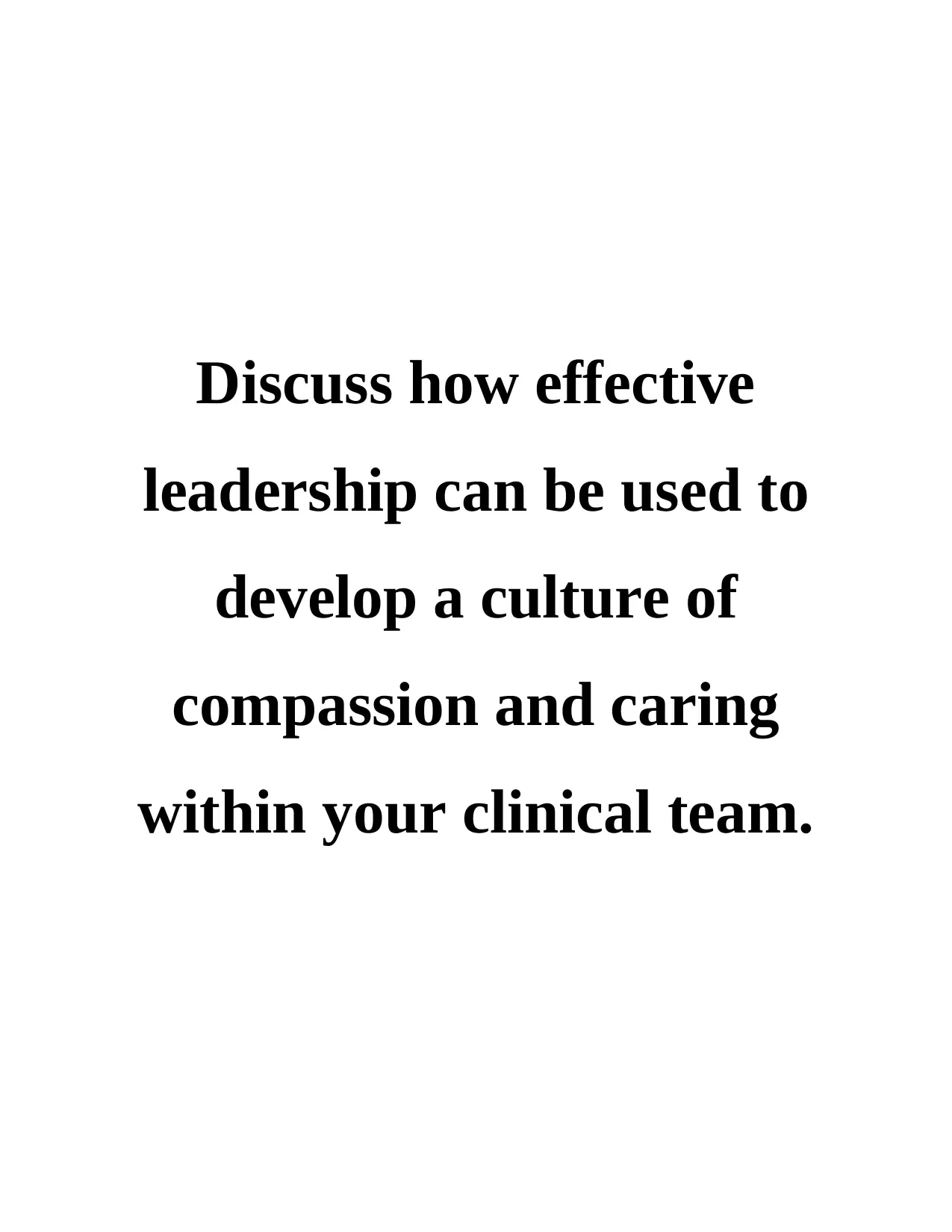
Discuss how effective
leadership can be used to
develop a culture of
compassion and caring
within your clinical team.
leadership can be used to
develop a culture of
compassion and caring
within your clinical team.
Paraphrase This Document
Need a fresh take? Get an instant paraphrase of this document with our AI Paraphraser
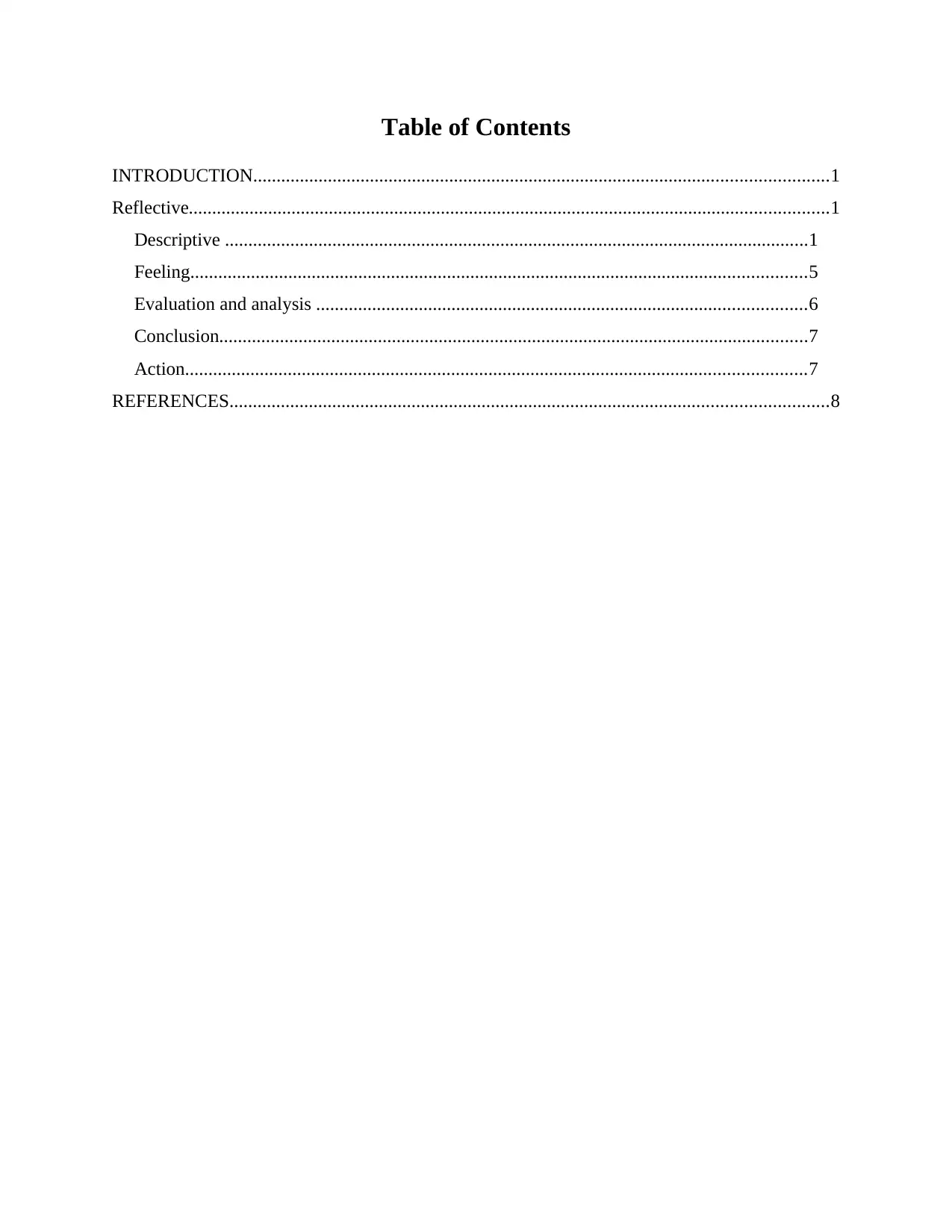
Table of Contents
INTRODUCTION...........................................................................................................................1
Reflective.........................................................................................................................................1
Descriptive .............................................................................................................................1
Feeling....................................................................................................................................5
Evaluation and analysis .........................................................................................................6
Conclusion..............................................................................................................................7
Action.....................................................................................................................................7
REFERENCES................................................................................................................................8
INTRODUCTION...........................................................................................................................1
Reflective.........................................................................................................................................1
Descriptive .............................................................................................................................1
Feeling....................................................................................................................................5
Evaluation and analysis .........................................................................................................6
Conclusion..............................................................................................................................7
Action.....................................................................................................................................7
REFERENCES................................................................................................................................8
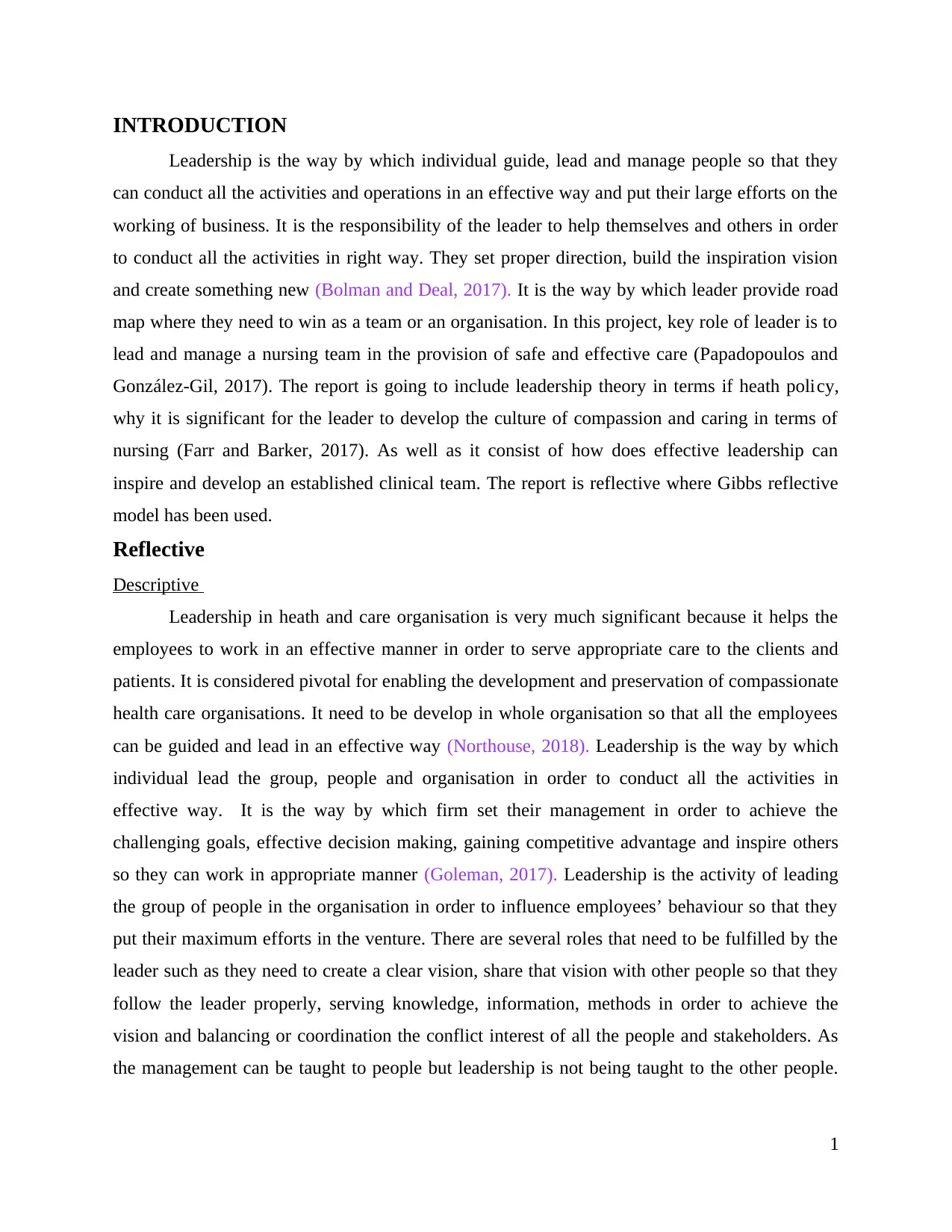
INTRODUCTION
Leadership is the way by which individual guide, lead and manage people so that they
can conduct all the activities and operations in an effective way and put their large efforts on the
working of business. It is the responsibility of the leader to help themselves and others in order
to conduct all the activities in right way. They set proper direction, build the inspiration vision
and create something new (Bolman and Deal, 2017). It is the way by which leader provide road
map where they need to win as a team or an organisation. In this project, key role of leader is to
lead and manage a nursing team in the provision of safe and effective care (Papadopoulos and
González-Gil, 2017). The report is going to include leadership theory in terms if heath policy,
why it is significant for the leader to develop the culture of compassion and caring in terms of
nursing (Farr and Barker, 2017). As well as it consist of how does effective leadership can
inspire and develop an established clinical team. The report is reflective where Gibbs reflective
model has been used.
Reflective
Descriptive
Leadership in heath and care organisation is very much significant because it helps the
employees to work in an effective manner in order to serve appropriate care to the clients and
patients. It is considered pivotal for enabling the development and preservation of compassionate
health care organisations. It need to be develop in whole organisation so that all the employees
can be guided and lead in an effective way (Northouse, 2018). Leadership is the way by which
individual lead the group, people and organisation in order to conduct all the activities in
effective way. It is the way by which firm set their management in order to achieve the
challenging goals, effective decision making, gaining competitive advantage and inspire others
so they can work in appropriate manner (Goleman, 2017). Leadership is the activity of leading
the group of people in the organisation in order to influence employees’ behaviour so that they
put their maximum efforts in the venture. There are several roles that need to be fulfilled by the
leader such as they need to create a clear vision, share that vision with other people so that they
follow the leader properly, serving knowledge, information, methods in order to achieve the
vision and balancing or coordination the conflict interest of all the people and stakeholders. As
the management can be taught to people but leadership is not being taught to the other people.
1
Leadership is the way by which individual guide, lead and manage people so that they
can conduct all the activities and operations in an effective way and put their large efforts on the
working of business. It is the responsibility of the leader to help themselves and others in order
to conduct all the activities in right way. They set proper direction, build the inspiration vision
and create something new (Bolman and Deal, 2017). It is the way by which leader provide road
map where they need to win as a team or an organisation. In this project, key role of leader is to
lead and manage a nursing team in the provision of safe and effective care (Papadopoulos and
González-Gil, 2017). The report is going to include leadership theory in terms if heath policy,
why it is significant for the leader to develop the culture of compassion and caring in terms of
nursing (Farr and Barker, 2017). As well as it consist of how does effective leadership can
inspire and develop an established clinical team. The report is reflective where Gibbs reflective
model has been used.
Reflective
Descriptive
Leadership in heath and care organisation is very much significant because it helps the
employees to work in an effective manner in order to serve appropriate care to the clients and
patients. It is considered pivotal for enabling the development and preservation of compassionate
health care organisations. It need to be develop in whole organisation so that all the employees
can be guided and lead in an effective way (Northouse, 2018). Leadership is the way by which
individual lead the group, people and organisation in order to conduct all the activities in
effective way. It is the way by which firm set their management in order to achieve the
challenging goals, effective decision making, gaining competitive advantage and inspire others
so they can work in appropriate manner (Goleman, 2017). Leadership is the activity of leading
the group of people in the organisation in order to influence employees’ behaviour so that they
put their maximum efforts in the venture. There are several roles that need to be fulfilled by the
leader such as they need to create a clear vision, share that vision with other people so that they
follow the leader properly, serving knowledge, information, methods in order to achieve the
vision and balancing or coordination the conflict interest of all the people and stakeholders. As
the management can be taught to people but leadership is not being taught to the other people.
1
⊘ This is a preview!⊘
Do you want full access?
Subscribe today to unlock all pages.

Trusted by 1+ million students worldwide
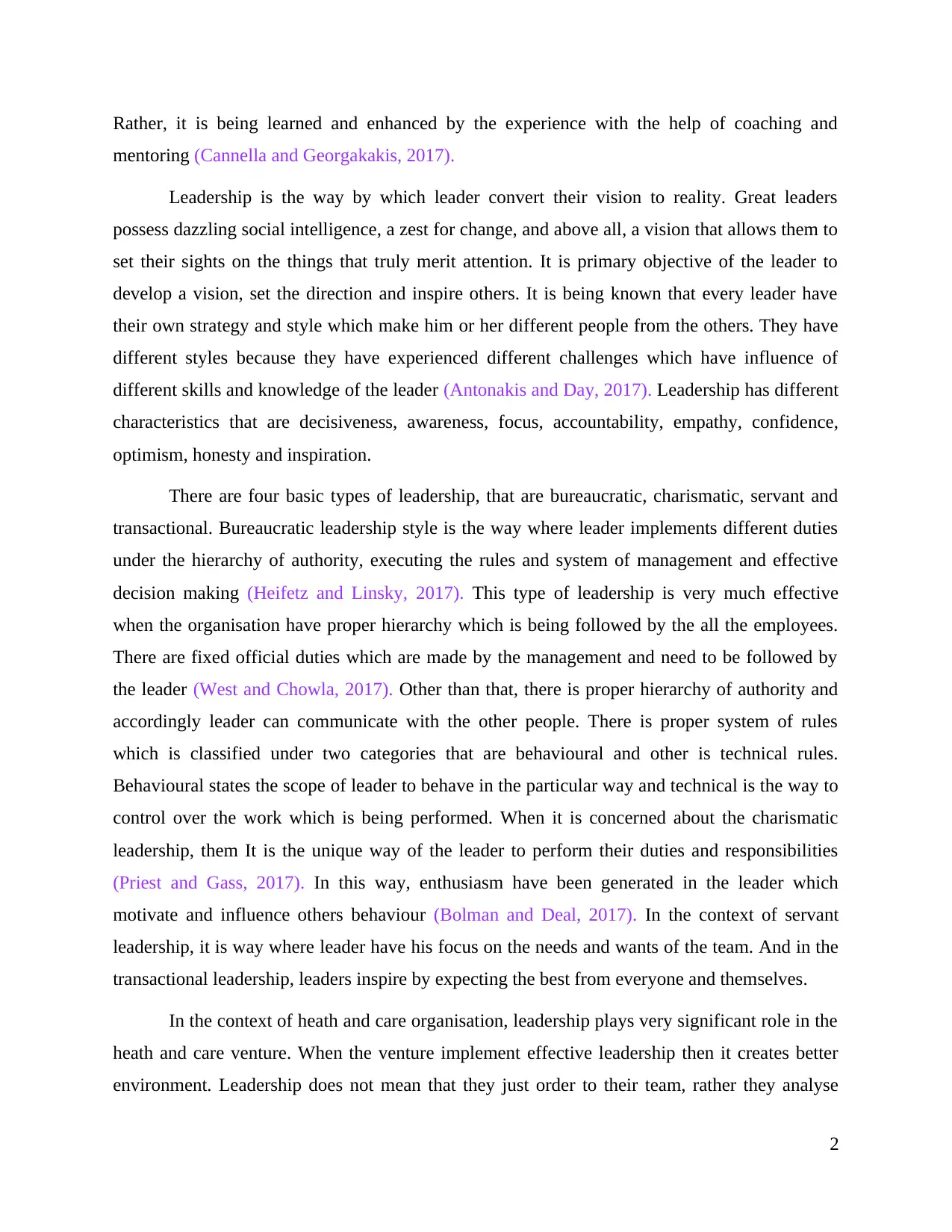
Rather, it is being learned and enhanced by the experience with the help of coaching and
mentoring (Cannella and Georgakakis, 2017).
Leadership is the way by which leader convert their vision to reality. Great leaders
possess dazzling social intelligence, a zest for change, and above all, a vision that allows them to
set their sights on the things that truly merit attention. It is primary objective of the leader to
develop a vision, set the direction and inspire others. It is being known that every leader have
their own strategy and style which make him or her different people from the others. They have
different styles because they have experienced different challenges which have influence of
different skills and knowledge of the leader (Antonakis and Day, 2017). Leadership has different
characteristics that are decisiveness, awareness, focus, accountability, empathy, confidence,
optimism, honesty and inspiration.
There are four basic types of leadership, that are bureaucratic, charismatic, servant and
transactional. Bureaucratic leadership style is the way where leader implements different duties
under the hierarchy of authority, executing the rules and system of management and effective
decision making (Heifetz and Linsky, 2017). This type of leadership is very much effective
when the organisation have proper hierarchy which is being followed by the all the employees.
There are fixed official duties which are made by the management and need to be followed by
the leader (West and Chowla, 2017). Other than that, there is proper hierarchy of authority and
accordingly leader can communicate with the other people. There is proper system of rules
which is classified under two categories that are behavioural and other is technical rules.
Behavioural states the scope of leader to behave in the particular way and technical is the way to
control over the work which is being performed. When it is concerned about the charismatic
leadership, them It is the unique way of the leader to perform their duties and responsibilities
(Priest and Gass, 2017). In this way, enthusiasm have been generated in the leader which
motivate and influence others behaviour (Bolman and Deal, 2017). In the context of servant
leadership, it is way where leader have his focus on the needs and wants of the team. And in the
transactional leadership, leaders inspire by expecting the best from everyone and themselves.
In the context of heath and care organisation, leadership plays very significant role in the
heath and care venture. When the venture implement effective leadership then it creates better
environment. Leadership does not mean that they just order to their team, rather they analyse
2
mentoring (Cannella and Georgakakis, 2017).
Leadership is the way by which leader convert their vision to reality. Great leaders
possess dazzling social intelligence, a zest for change, and above all, a vision that allows them to
set their sights on the things that truly merit attention. It is primary objective of the leader to
develop a vision, set the direction and inspire others. It is being known that every leader have
their own strategy and style which make him or her different people from the others. They have
different styles because they have experienced different challenges which have influence of
different skills and knowledge of the leader (Antonakis and Day, 2017). Leadership has different
characteristics that are decisiveness, awareness, focus, accountability, empathy, confidence,
optimism, honesty and inspiration.
There are four basic types of leadership, that are bureaucratic, charismatic, servant and
transactional. Bureaucratic leadership style is the way where leader implements different duties
under the hierarchy of authority, executing the rules and system of management and effective
decision making (Heifetz and Linsky, 2017). This type of leadership is very much effective
when the organisation have proper hierarchy which is being followed by the all the employees.
There are fixed official duties which are made by the management and need to be followed by
the leader (West and Chowla, 2017). Other than that, there is proper hierarchy of authority and
accordingly leader can communicate with the other people. There is proper system of rules
which is classified under two categories that are behavioural and other is technical rules.
Behavioural states the scope of leader to behave in the particular way and technical is the way to
control over the work which is being performed. When it is concerned about the charismatic
leadership, them It is the unique way of the leader to perform their duties and responsibilities
(Priest and Gass, 2017). In this way, enthusiasm have been generated in the leader which
motivate and influence others behaviour (Bolman and Deal, 2017). In the context of servant
leadership, it is way where leader have his focus on the needs and wants of the team. And in the
transactional leadership, leaders inspire by expecting the best from everyone and themselves.
In the context of heath and care organisation, leadership plays very significant role in the
heath and care venture. When the venture implement effective leadership then it creates better
environment. Leadership does not mean that they just order to their team, rather they analyse
2
Paraphrase This Document
Need a fresh take? Get an instant paraphrase of this document with our AI Paraphraser
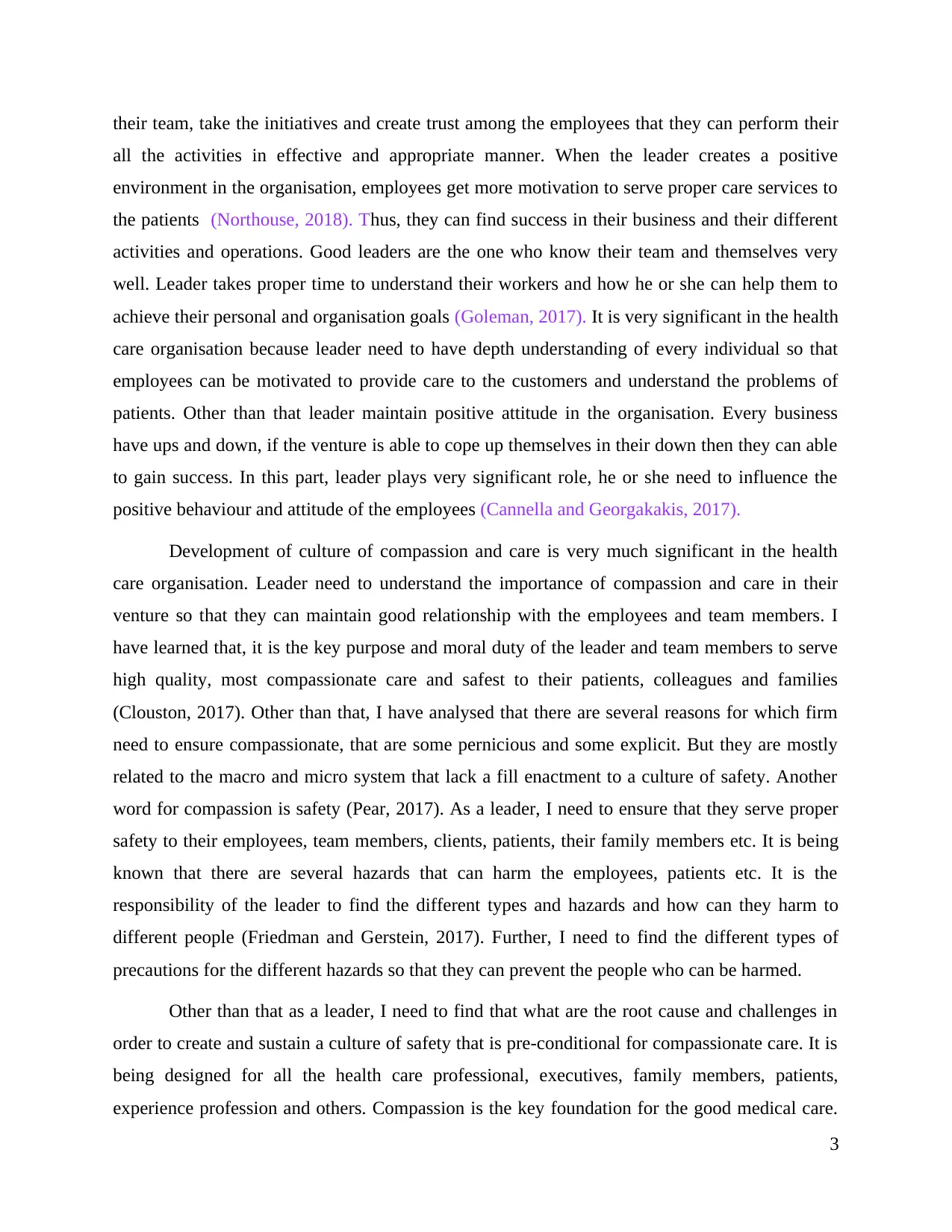
their team, take the initiatives and create trust among the employees that they can perform their
all the activities in effective and appropriate manner. When the leader creates a positive
environment in the organisation, employees get more motivation to serve proper care services to
the patients (Northouse, 2018). Thus, they can find success in their business and their different
activities and operations. Good leaders are the one who know their team and themselves very
well. Leader takes proper time to understand their workers and how he or she can help them to
achieve their personal and organisation goals (Goleman, 2017). It is very significant in the health
care organisation because leader need to have depth understanding of every individual so that
employees can be motivated to provide care to the customers and understand the problems of
patients. Other than that leader maintain positive attitude in the organisation. Every business
have ups and down, if the venture is able to cope up themselves in their down then they can able
to gain success. In this part, leader plays very significant role, he or she need to influence the
positive behaviour and attitude of the employees (Cannella and Georgakakis, 2017).
Development of culture of compassion and care is very much significant in the health
care organisation. Leader need to understand the importance of compassion and care in their
venture so that they can maintain good relationship with the employees and team members. I
have learned that, it is the key purpose and moral duty of the leader and team members to serve
high quality, most compassionate care and safest to their patients, colleagues and families
(Clouston, 2017). Other than that, I have analysed that there are several reasons for which firm
need to ensure compassionate, that are some pernicious and some explicit. But they are mostly
related to the macro and micro system that lack a fill enactment to a culture of safety. Another
word for compassion is safety (Pear, 2017). As a leader, I need to ensure that they serve proper
safety to their employees, team members, clients, patients, their family members etc. It is being
known that there are several hazards that can harm the employees, patients etc. It is the
responsibility of the leader to find the different types and hazards and how can they harm to
different people (Friedman and Gerstein, 2017). Further, I need to find the different types of
precautions for the different hazards so that they can prevent the people who can be harmed.
Other than that as a leader, I need to find that what are the root cause and challenges in
order to create and sustain a culture of safety that is pre-conditional for compassionate care. It is
being designed for all the health care professional, executives, family members, patients,
experience profession and others. Compassion is the key foundation for the good medical care.
3
all the activities in effective and appropriate manner. When the leader creates a positive
environment in the organisation, employees get more motivation to serve proper care services to
the patients (Northouse, 2018). Thus, they can find success in their business and their different
activities and operations. Good leaders are the one who know their team and themselves very
well. Leader takes proper time to understand their workers and how he or she can help them to
achieve their personal and organisation goals (Goleman, 2017). It is very significant in the health
care organisation because leader need to have depth understanding of every individual so that
employees can be motivated to provide care to the customers and understand the problems of
patients. Other than that leader maintain positive attitude in the organisation. Every business
have ups and down, if the venture is able to cope up themselves in their down then they can able
to gain success. In this part, leader plays very significant role, he or she need to influence the
positive behaviour and attitude of the employees (Cannella and Georgakakis, 2017).
Development of culture of compassion and care is very much significant in the health
care organisation. Leader need to understand the importance of compassion and care in their
venture so that they can maintain good relationship with the employees and team members. I
have learned that, it is the key purpose and moral duty of the leader and team members to serve
high quality, most compassionate care and safest to their patients, colleagues and families
(Clouston, 2017). Other than that, I have analysed that there are several reasons for which firm
need to ensure compassionate, that are some pernicious and some explicit. But they are mostly
related to the macro and micro system that lack a fill enactment to a culture of safety. Another
word for compassion is safety (Pear, 2017). As a leader, I need to ensure that they serve proper
safety to their employees, team members, clients, patients, their family members etc. It is being
known that there are several hazards that can harm the employees, patients etc. It is the
responsibility of the leader to find the different types and hazards and how can they harm to
different people (Friedman and Gerstein, 2017). Further, I need to find the different types of
precautions for the different hazards so that they can prevent the people who can be harmed.
Other than that as a leader, I need to find that what are the root cause and challenges in
order to create and sustain a culture of safety that is pre-conditional for compassionate care. It is
being designed for all the health care professional, executives, family members, patients,
experience profession and others. Compassion is the key foundation for the good medical care.
3
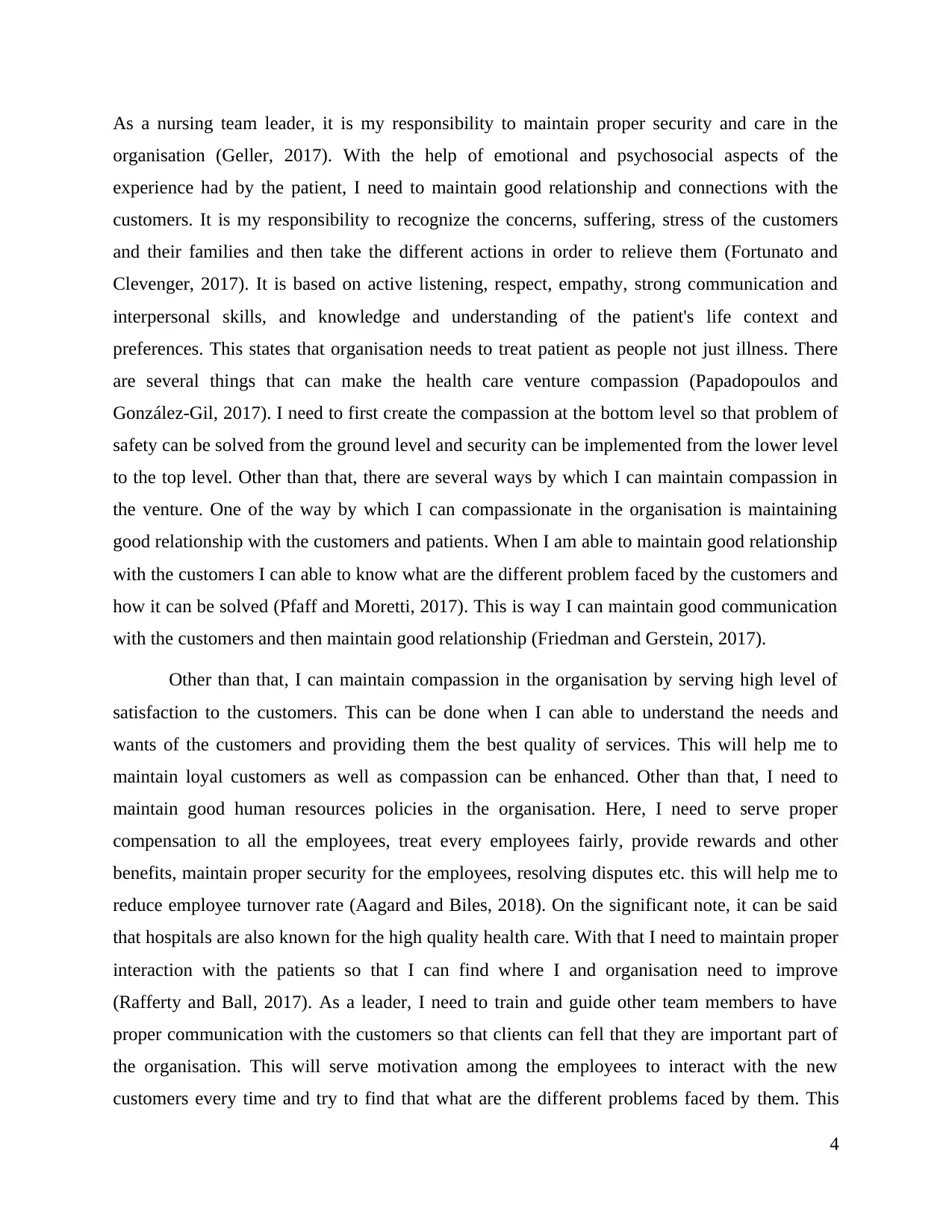
As a nursing team leader, it is my responsibility to maintain proper security and care in the
organisation (Geller, 2017). With the help of emotional and psychosocial aspects of the
experience had by the patient, I need to maintain good relationship and connections with the
customers. It is my responsibility to recognize the concerns, suffering, stress of the customers
and their families and then take the different actions in order to relieve them (Fortunato and
Clevenger, 2017). It is based on active listening, respect, empathy, strong communication and
interpersonal skills, and knowledge and understanding of the patient's life context and
preferences. This states that organisation needs to treat patient as people not just illness. There
are several things that can make the health care venture compassion (Papadopoulos and
González-Gil, 2017). I need to first create the compassion at the bottom level so that problem of
safety can be solved from the ground level and security can be implemented from the lower level
to the top level. Other than that, there are several ways by which I can maintain compassion in
the venture. One of the way by which I can compassionate in the organisation is maintaining
good relationship with the customers and patients. When I am able to maintain good relationship
with the customers I can able to know what are the different problem faced by the customers and
how it can be solved (Pfaff and Moretti, 2017). This is way I can maintain good communication
with the customers and then maintain good relationship (Friedman and Gerstein, 2017).
Other than that, I can maintain compassion in the organisation by serving high level of
satisfaction to the customers. This can be done when I can able to understand the needs and
wants of the customers and providing them the best quality of services. This will help me to
maintain loyal customers as well as compassion can be enhanced. Other than that, I need to
maintain good human resources policies in the organisation. Here, I need to serve proper
compensation to all the employees, treat every employees fairly, provide rewards and other
benefits, maintain proper security for the employees, resolving disputes etc. this will help me to
reduce employee turnover rate (Aagard and Biles, 2018). On the significant note, it can be said
that hospitals are also known for the high quality health care. With that I need to maintain proper
interaction with the patients so that I can find where I and organisation need to improve
(Rafferty and Ball, 2017). As a leader, I need to train and guide other team members to have
proper communication with the customers so that clients can fell that they are important part of
the organisation. This will serve motivation among the employees to interact with the new
customers every time and try to find that what are the different problems faced by them. This
4
organisation (Geller, 2017). With the help of emotional and psychosocial aspects of the
experience had by the patient, I need to maintain good relationship and connections with the
customers. It is my responsibility to recognize the concerns, suffering, stress of the customers
and their families and then take the different actions in order to relieve them (Fortunato and
Clevenger, 2017). It is based on active listening, respect, empathy, strong communication and
interpersonal skills, and knowledge and understanding of the patient's life context and
preferences. This states that organisation needs to treat patient as people not just illness. There
are several things that can make the health care venture compassion (Papadopoulos and
González-Gil, 2017). I need to first create the compassion at the bottom level so that problem of
safety can be solved from the ground level and security can be implemented from the lower level
to the top level. Other than that, there are several ways by which I can maintain compassion in
the venture. One of the way by which I can compassionate in the organisation is maintaining
good relationship with the customers and patients. When I am able to maintain good relationship
with the customers I can able to know what are the different problem faced by the customers and
how it can be solved (Pfaff and Moretti, 2017). This is way I can maintain good communication
with the customers and then maintain good relationship (Friedman and Gerstein, 2017).
Other than that, I can maintain compassion in the organisation by serving high level of
satisfaction to the customers. This can be done when I can able to understand the needs and
wants of the customers and providing them the best quality of services. This will help me to
maintain loyal customers as well as compassion can be enhanced. Other than that, I need to
maintain good human resources policies in the organisation. Here, I need to serve proper
compensation to all the employees, treat every employees fairly, provide rewards and other
benefits, maintain proper security for the employees, resolving disputes etc. this will help me to
reduce employee turnover rate (Aagard and Biles, 2018). On the significant note, it can be said
that hospitals are also known for the high quality health care. With that I need to maintain proper
interaction with the patients so that I can find where I and organisation need to improve
(Rafferty and Ball, 2017). As a leader, I need to train and guide other team members to have
proper communication with the customers so that clients can fell that they are important part of
the organisation. This will serve motivation among the employees to interact with the new
customers every time and try to find that what are the different problems faced by them. This
4
⊘ This is a preview!⊘
Do you want full access?
Subscribe today to unlock all pages.

Trusted by 1+ million students worldwide
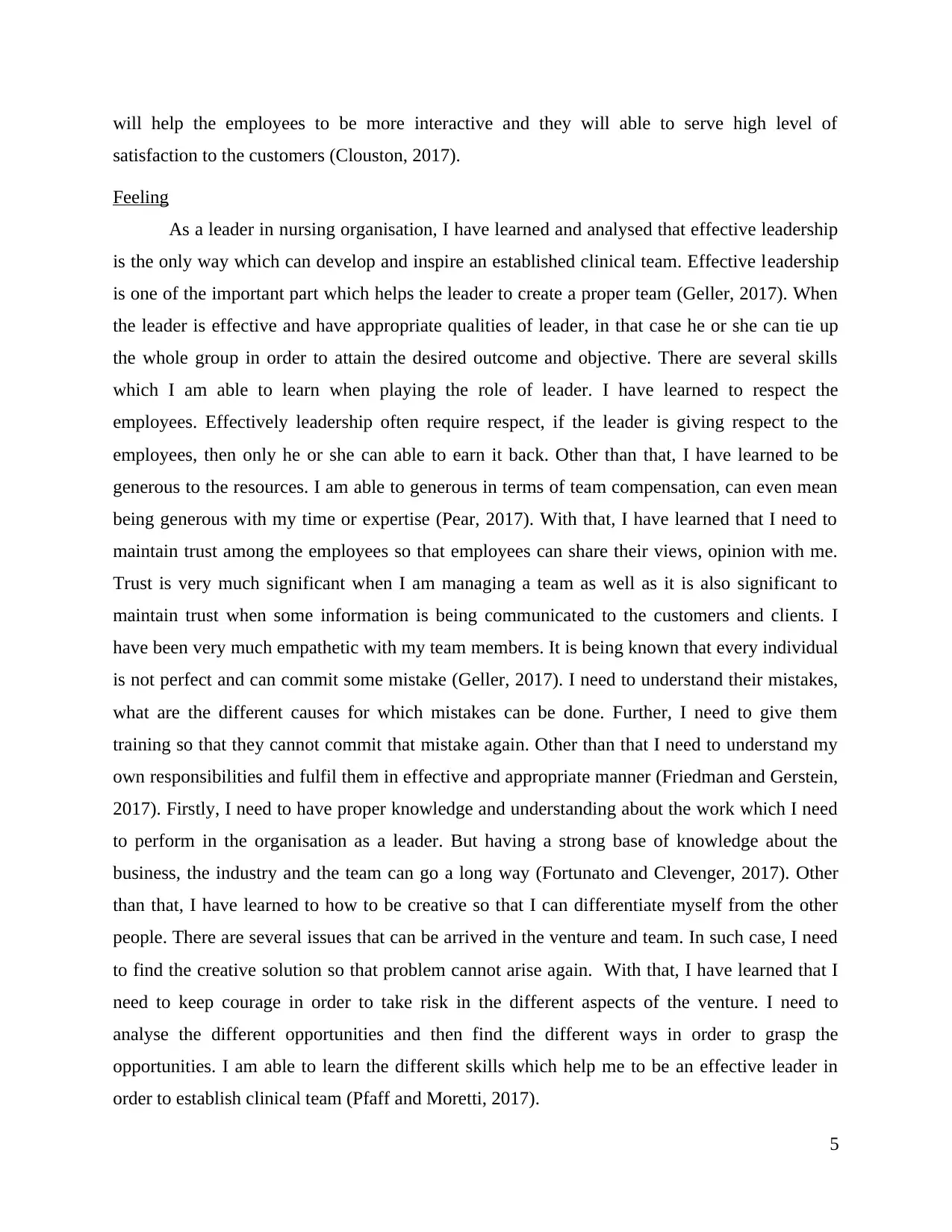
will help the employees to be more interactive and they will able to serve high level of
satisfaction to the customers (Clouston, 2017).
Feeling
As a leader in nursing organisation, I have learned and analysed that effective leadership
is the only way which can develop and inspire an established clinical team. Effective leadership
is one of the important part which helps the leader to create a proper team (Geller, 2017). When
the leader is effective and have appropriate qualities of leader, in that case he or she can tie up
the whole group in order to attain the desired outcome and objective. There are several skills
which I am able to learn when playing the role of leader. I have learned to respect the
employees. Effectively leadership often require respect, if the leader is giving respect to the
employees, then only he or she can able to earn it back. Other than that, I have learned to be
generous to the resources. I am able to generous in terms of team compensation, can even mean
being generous with my time or expertise (Pear, 2017). With that, I have learned that I need to
maintain trust among the employees so that employees can share their views, opinion with me.
Trust is very much significant when I am managing a team as well as it is also significant to
maintain trust when some information is being communicated to the customers and clients. I
have been very much empathetic with my team members. It is being known that every individual
is not perfect and can commit some mistake (Geller, 2017). I need to understand their mistakes,
what are the different causes for which mistakes can be done. Further, I need to give them
training so that they cannot commit that mistake again. Other than that I need to understand my
own responsibilities and fulfil them in effective and appropriate manner (Friedman and Gerstein,
2017). Firstly, I need to have proper knowledge and understanding about the work which I need
to perform in the organisation as a leader. But having a strong base of knowledge about the
business, the industry and the team can go a long way (Fortunato and Clevenger, 2017). Other
than that, I have learned to how to be creative so that I can differentiate myself from the other
people. There are several issues that can be arrived in the venture and team. In such case, I need
to find the creative solution so that problem cannot arise again. With that, I have learned that I
need to keep courage in order to take risk in the different aspects of the venture. I need to
analyse the different opportunities and then find the different ways in order to grasp the
opportunities. I am able to learn the different skills which help me to be an effective leader in
order to establish clinical team (Pfaff and Moretti, 2017).
5
satisfaction to the customers (Clouston, 2017).
Feeling
As a leader in nursing organisation, I have learned and analysed that effective leadership
is the only way which can develop and inspire an established clinical team. Effective leadership
is one of the important part which helps the leader to create a proper team (Geller, 2017). When
the leader is effective and have appropriate qualities of leader, in that case he or she can tie up
the whole group in order to attain the desired outcome and objective. There are several skills
which I am able to learn when playing the role of leader. I have learned to respect the
employees. Effectively leadership often require respect, if the leader is giving respect to the
employees, then only he or she can able to earn it back. Other than that, I have learned to be
generous to the resources. I am able to generous in terms of team compensation, can even mean
being generous with my time or expertise (Pear, 2017). With that, I have learned that I need to
maintain trust among the employees so that employees can share their views, opinion with me.
Trust is very much significant when I am managing a team as well as it is also significant to
maintain trust when some information is being communicated to the customers and clients. I
have been very much empathetic with my team members. It is being known that every individual
is not perfect and can commit some mistake (Geller, 2017). I need to understand their mistakes,
what are the different causes for which mistakes can be done. Further, I need to give them
training so that they cannot commit that mistake again. Other than that I need to understand my
own responsibilities and fulfil them in effective and appropriate manner (Friedman and Gerstein,
2017). Firstly, I need to have proper knowledge and understanding about the work which I need
to perform in the organisation as a leader. But having a strong base of knowledge about the
business, the industry and the team can go a long way (Fortunato and Clevenger, 2017). Other
than that, I have learned to how to be creative so that I can differentiate myself from the other
people. There are several issues that can be arrived in the venture and team. In such case, I need
to find the creative solution so that problem cannot arise again. With that, I have learned that I
need to keep courage in order to take risk in the different aspects of the venture. I need to
analyse the different opportunities and then find the different ways in order to grasp the
opportunities. I am able to learn the different skills which help me to be an effective leader in
order to establish clinical team (Pfaff and Moretti, 2017).
5
Paraphrase This Document
Need a fresh take? Get an instant paraphrase of this document with our AI Paraphraser
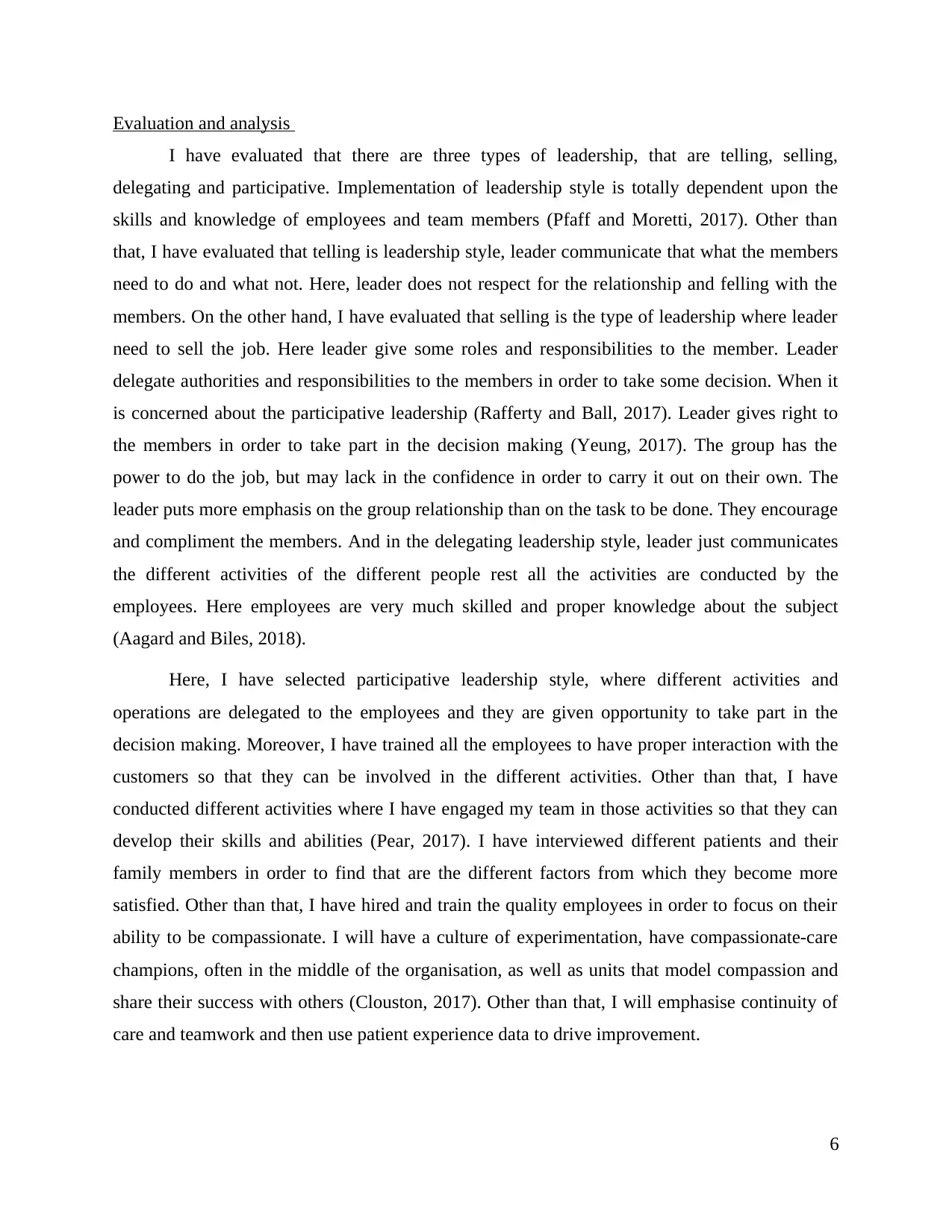
Evaluation and analysis
I have evaluated that there are three types of leadership, that are telling, selling,
delegating and participative. Implementation of leadership style is totally dependent upon the
skills and knowledge of employees and team members (Pfaff and Moretti, 2017). Other than
that, I have evaluated that telling is leadership style, leader communicate that what the members
need to do and what not. Here, leader does not respect for the relationship and felling with the
members. On the other hand, I have evaluated that selling is the type of leadership where leader
need to sell the job. Here leader give some roles and responsibilities to the member. Leader
delegate authorities and responsibilities to the members in order to take some decision. When it
is concerned about the participative leadership (Rafferty and Ball, 2017). Leader gives right to
the members in order to take part in the decision making (Yeung, 2017). The group has the
power to do the job, but may lack in the confidence in order to carry it out on their own. The
leader puts more emphasis on the group relationship than on the task to be done. They encourage
and compliment the members. And in the delegating leadership style, leader just communicates
the different activities of the different people rest all the activities are conducted by the
employees. Here employees are very much skilled and proper knowledge about the subject
(Aagard and Biles, 2018).
Here, I have selected participative leadership style, where different activities and
operations are delegated to the employees and they are given opportunity to take part in the
decision making. Moreover, I have trained all the employees to have proper interaction with the
customers so that they can be involved in the different activities. Other than that, I have
conducted different activities where I have engaged my team in those activities so that they can
develop their skills and abilities (Pear, 2017). I have interviewed different patients and their
family members in order to find that are the different factors from which they become more
satisfied. Other than that, I have hired and train the quality employees in order to focus on their
ability to be compassionate. I will have a culture of experimentation, have compassionate-care
champions, often in the middle of the organisation, as well as units that model compassion and
share their success with others (Clouston, 2017). Other than that, I will emphasise continuity of
care and teamwork and then use patient experience data to drive improvement.
6
I have evaluated that there are three types of leadership, that are telling, selling,
delegating and participative. Implementation of leadership style is totally dependent upon the
skills and knowledge of employees and team members (Pfaff and Moretti, 2017). Other than
that, I have evaluated that telling is leadership style, leader communicate that what the members
need to do and what not. Here, leader does not respect for the relationship and felling with the
members. On the other hand, I have evaluated that selling is the type of leadership where leader
need to sell the job. Here leader give some roles and responsibilities to the member. Leader
delegate authorities and responsibilities to the members in order to take some decision. When it
is concerned about the participative leadership (Rafferty and Ball, 2017). Leader gives right to
the members in order to take part in the decision making (Yeung, 2017). The group has the
power to do the job, but may lack in the confidence in order to carry it out on their own. The
leader puts more emphasis on the group relationship than on the task to be done. They encourage
and compliment the members. And in the delegating leadership style, leader just communicates
the different activities of the different people rest all the activities are conducted by the
employees. Here employees are very much skilled and proper knowledge about the subject
(Aagard and Biles, 2018).
Here, I have selected participative leadership style, where different activities and
operations are delegated to the employees and they are given opportunity to take part in the
decision making. Moreover, I have trained all the employees to have proper interaction with the
customers so that they can be involved in the different activities. Other than that, I have
conducted different activities where I have engaged my team in those activities so that they can
develop their skills and abilities (Pear, 2017). I have interviewed different patients and their
family members in order to find that are the different factors from which they become more
satisfied. Other than that, I have hired and train the quality employees in order to focus on their
ability to be compassionate. I will have a culture of experimentation, have compassionate-care
champions, often in the middle of the organisation, as well as units that model compassion and
share their success with others (Clouston, 2017). Other than that, I will emphasise continuity of
care and teamwork and then use patient experience data to drive improvement.
6
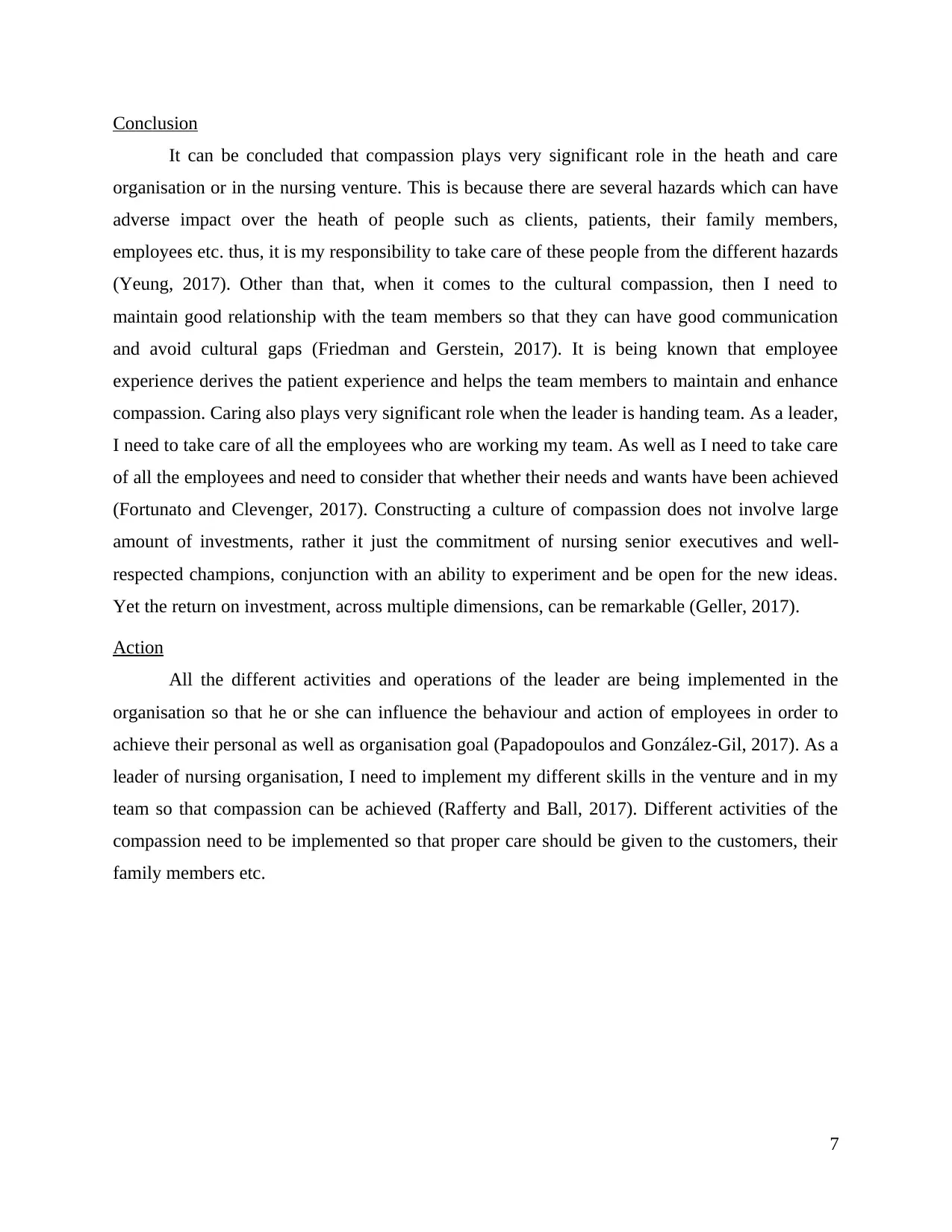
Conclusion
It can be concluded that compassion plays very significant role in the heath and care
organisation or in the nursing venture. This is because there are several hazards which can have
adverse impact over the heath of people such as clients, patients, their family members,
employees etc. thus, it is my responsibility to take care of these people from the different hazards
(Yeung, 2017). Other than that, when it comes to the cultural compassion, then I need to
maintain good relationship with the team members so that they can have good communication
and avoid cultural gaps (Friedman and Gerstein, 2017). It is being known that employee
experience derives the patient experience and helps the team members to maintain and enhance
compassion. Caring also plays very significant role when the leader is handing team. As a leader,
I need to take care of all the employees who are working my team. As well as I need to take care
of all the employees and need to consider that whether their needs and wants have been achieved
(Fortunato and Clevenger, 2017). Constructing a culture of compassion does not involve large
amount of investments, rather it just the commitment of nursing senior executives and well-
respected champions, conjunction with an ability to experiment and be open for the new ideas.
Yet the return on investment, across multiple dimensions, can be remarkable (Geller, 2017).
Action
All the different activities and operations of the leader are being implemented in the
organisation so that he or she can influence the behaviour and action of employees in order to
achieve their personal as well as organisation goal (Papadopoulos and González-Gil, 2017). As a
leader of nursing organisation, I need to implement my different skills in the venture and in my
team so that compassion can be achieved (Rafferty and Ball, 2017). Different activities of the
compassion need to be implemented so that proper care should be given to the customers, their
family members etc.
7
It can be concluded that compassion plays very significant role in the heath and care
organisation or in the nursing venture. This is because there are several hazards which can have
adverse impact over the heath of people such as clients, patients, their family members,
employees etc. thus, it is my responsibility to take care of these people from the different hazards
(Yeung, 2017). Other than that, when it comes to the cultural compassion, then I need to
maintain good relationship with the team members so that they can have good communication
and avoid cultural gaps (Friedman and Gerstein, 2017). It is being known that employee
experience derives the patient experience and helps the team members to maintain and enhance
compassion. Caring also plays very significant role when the leader is handing team. As a leader,
I need to take care of all the employees who are working my team. As well as I need to take care
of all the employees and need to consider that whether their needs and wants have been achieved
(Fortunato and Clevenger, 2017). Constructing a culture of compassion does not involve large
amount of investments, rather it just the commitment of nursing senior executives and well-
respected champions, conjunction with an ability to experiment and be open for the new ideas.
Yet the return on investment, across multiple dimensions, can be remarkable (Geller, 2017).
Action
All the different activities and operations of the leader are being implemented in the
organisation so that he or she can influence the behaviour and action of employees in order to
achieve their personal as well as organisation goal (Papadopoulos and González-Gil, 2017). As a
leader of nursing organisation, I need to implement my different skills in the venture and in my
team so that compassion can be achieved (Rafferty and Ball, 2017). Different activities of the
compassion need to be implemented so that proper care should be given to the customers, their
family members etc.
7
⊘ This is a preview!⊘
Do you want full access?
Subscribe today to unlock all pages.

Trusted by 1+ million students worldwide
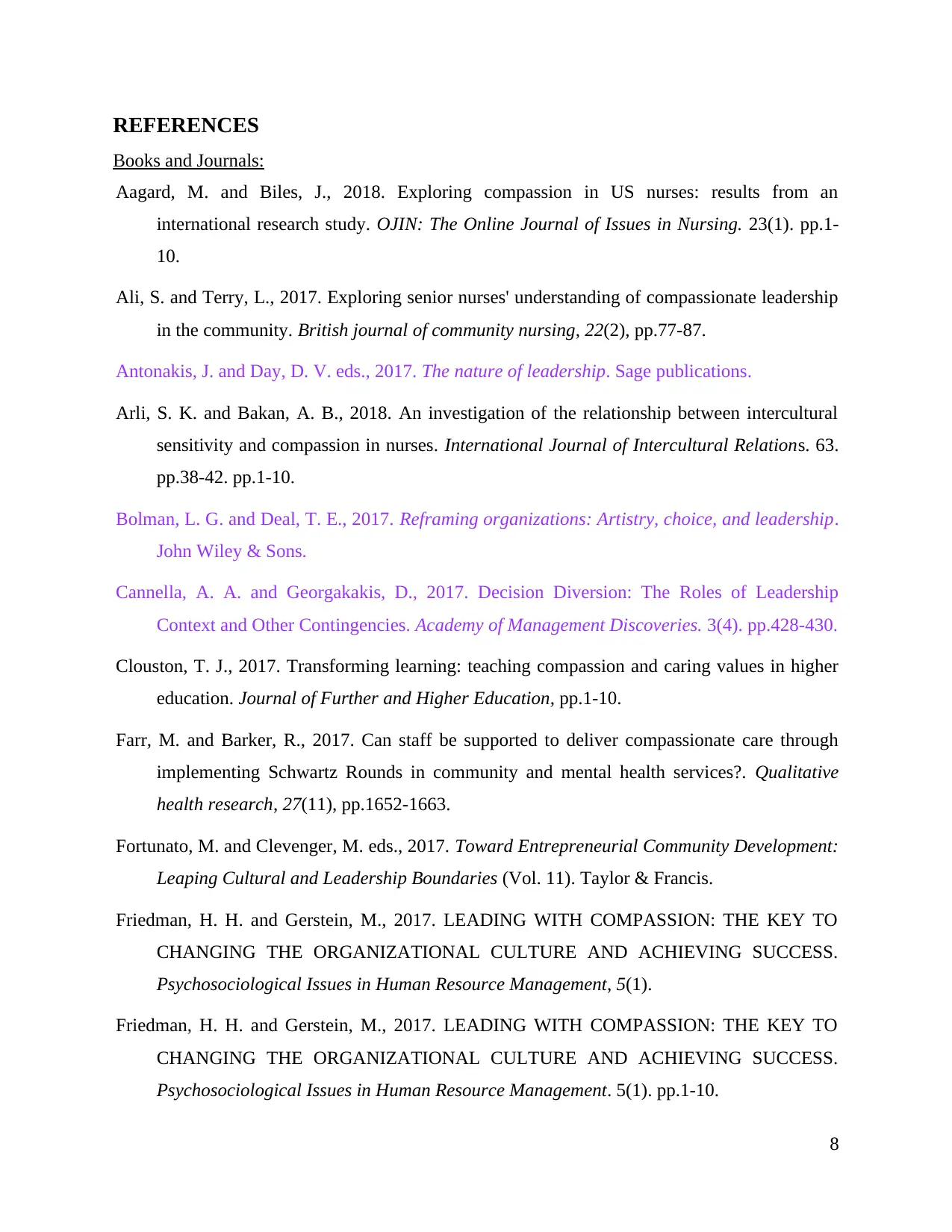
REFERENCES
Books and Journals:
Aagard, M. and Biles, J., 2018. Exploring compassion in US nurses: results from an
international research study. OJIN: The Online Journal of Issues in Nursing. 23(1). pp.1-
10.
Ali, S. and Terry, L., 2017. Exploring senior nurses' understanding of compassionate leadership
in the community. British journal of community nursing, 22(2), pp.77-87.
Antonakis, J. and Day, D. V. eds., 2017. The nature of leadership. Sage publications.
Arli, S. K. and Bakan, A. B., 2018. An investigation of the relationship between intercultural
sensitivity and compassion in nurses. International Journal of Intercultural Relations. 63.
pp.38-42. pp.1-10.
Bolman, L. G. and Deal, T. E., 2017. Reframing organizations: Artistry, choice, and leadership.
John Wiley & Sons.
Cannella, A. A. and Georgakakis, D., 2017. Decision Diversion: The Roles of Leadership
Context and Other Contingencies. Academy of Management Discoveries. 3(4). pp.428-430.
Clouston, T. J., 2017. Transforming learning: teaching compassion and caring values in higher
education. Journal of Further and Higher Education, pp.1-10.
Farr, M. and Barker, R., 2017. Can staff be supported to deliver compassionate care through
implementing Schwartz Rounds in community and mental health services?. Qualitative
health research, 27(11), pp.1652-1663.
Fortunato, M. and Clevenger, M. eds., 2017. Toward Entrepreneurial Community Development:
Leaping Cultural and Leadership Boundaries (Vol. 11). Taylor & Francis.
Friedman, H. H. and Gerstein, M., 2017. LEADING WITH COMPASSION: THE KEY TO
CHANGING THE ORGANIZATIONAL CULTURE AND ACHIEVING SUCCESS.
Psychosociological Issues in Human Resource Management, 5(1).
Friedman, H. H. and Gerstein, M., 2017. LEADING WITH COMPASSION: THE KEY TO
CHANGING THE ORGANIZATIONAL CULTURE AND ACHIEVING SUCCESS.
Psychosociological Issues in Human Resource Management. 5(1). pp.1-10.
8
Books and Journals:
Aagard, M. and Biles, J., 2018. Exploring compassion in US nurses: results from an
international research study. OJIN: The Online Journal of Issues in Nursing. 23(1). pp.1-
10.
Ali, S. and Terry, L., 2017. Exploring senior nurses' understanding of compassionate leadership
in the community. British journal of community nursing, 22(2), pp.77-87.
Antonakis, J. and Day, D. V. eds., 2017. The nature of leadership. Sage publications.
Arli, S. K. and Bakan, A. B., 2018. An investigation of the relationship between intercultural
sensitivity and compassion in nurses. International Journal of Intercultural Relations. 63.
pp.38-42. pp.1-10.
Bolman, L. G. and Deal, T. E., 2017. Reframing organizations: Artistry, choice, and leadership.
John Wiley & Sons.
Cannella, A. A. and Georgakakis, D., 2017. Decision Diversion: The Roles of Leadership
Context and Other Contingencies. Academy of Management Discoveries. 3(4). pp.428-430.
Clouston, T. J., 2017. Transforming learning: teaching compassion and caring values in higher
education. Journal of Further and Higher Education, pp.1-10.
Farr, M. and Barker, R., 2017. Can staff be supported to deliver compassionate care through
implementing Schwartz Rounds in community and mental health services?. Qualitative
health research, 27(11), pp.1652-1663.
Fortunato, M. and Clevenger, M. eds., 2017. Toward Entrepreneurial Community Development:
Leaping Cultural and Leadership Boundaries (Vol. 11). Taylor & Francis.
Friedman, H. H. and Gerstein, M., 2017. LEADING WITH COMPASSION: THE KEY TO
CHANGING THE ORGANIZATIONAL CULTURE AND ACHIEVING SUCCESS.
Psychosociological Issues in Human Resource Management, 5(1).
Friedman, H. H. and Gerstein, M., 2017. LEADING WITH COMPASSION: THE KEY TO
CHANGING THE ORGANIZATIONAL CULTURE AND ACHIEVING SUCCESS.
Psychosociological Issues in Human Resource Management. 5(1). pp.1-10.
8
Paraphrase This Document
Need a fresh take? Get an instant paraphrase of this document with our AI Paraphraser
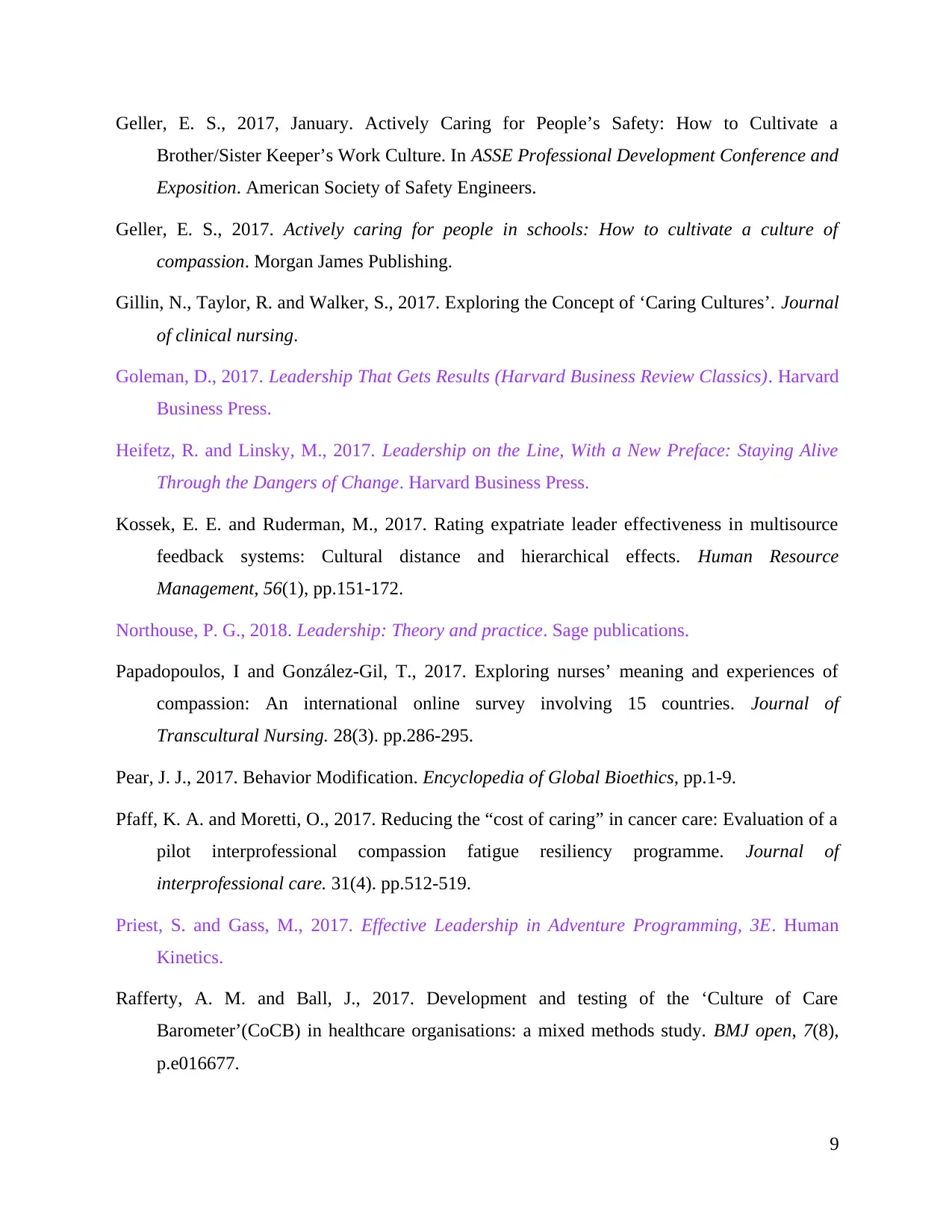
Geller, E. S., 2017, January. Actively Caring for People’s Safety: How to Cultivate a
Brother/Sister Keeper’s Work Culture. In ASSE Professional Development Conference and
Exposition. American Society of Safety Engineers.
Geller, E. S., 2017. Actively caring for people in schools: How to cultivate a culture of
compassion. Morgan James Publishing.
Gillin, N., Taylor, R. and Walker, S., 2017. Exploring the Concept of ‘Caring Cultures’. Journal
of clinical nursing.
Goleman, D., 2017. Leadership That Gets Results (Harvard Business Review Classics). Harvard
Business Press.
Heifetz, R. and Linsky, M., 2017. Leadership on the Line, With a New Preface: Staying Alive
Through the Dangers of Change. Harvard Business Press.
Kossek, E. E. and Ruderman, M., 2017. Rating expatriate leader effectiveness in multisource
feedback systems: Cultural distance and hierarchical effects. Human Resource
Management, 56(1), pp.151-172.
Northouse, P. G., 2018. Leadership: Theory and practice. Sage publications.
Papadopoulos, I and González-Gil, T., 2017. Exploring nurses’ meaning and experiences of
compassion: An international online survey involving 15 countries. Journal of
Transcultural Nursing. 28(3). pp.286-295.
Pear, J. J., 2017. Behavior Modification. Encyclopedia of Global Bioethics, pp.1-9.
Pfaff, K. A. and Moretti, O., 2017. Reducing the “cost of caring” in cancer care: Evaluation of a
pilot interprofessional compassion fatigue resiliency programme. Journal of
interprofessional care. 31(4). pp.512-519.
Priest, S. and Gass, M., 2017. Effective Leadership in Adventure Programming, 3E. Human
Kinetics.
Rafferty, A. M. and Ball, J., 2017. Development and testing of the ‘Culture of Care
Barometer’(CoCB) in healthcare organisations: a mixed methods study. BMJ open, 7(8),
p.e016677.
9
Brother/Sister Keeper’s Work Culture. In ASSE Professional Development Conference and
Exposition. American Society of Safety Engineers.
Geller, E. S., 2017. Actively caring for people in schools: How to cultivate a culture of
compassion. Morgan James Publishing.
Gillin, N., Taylor, R. and Walker, S., 2017. Exploring the Concept of ‘Caring Cultures’. Journal
of clinical nursing.
Goleman, D., 2017. Leadership That Gets Results (Harvard Business Review Classics). Harvard
Business Press.
Heifetz, R. and Linsky, M., 2017. Leadership on the Line, With a New Preface: Staying Alive
Through the Dangers of Change. Harvard Business Press.
Kossek, E. E. and Ruderman, M., 2017. Rating expatriate leader effectiveness in multisource
feedback systems: Cultural distance and hierarchical effects. Human Resource
Management, 56(1), pp.151-172.
Northouse, P. G., 2018. Leadership: Theory and practice. Sage publications.
Papadopoulos, I and González-Gil, T., 2017. Exploring nurses’ meaning and experiences of
compassion: An international online survey involving 15 countries. Journal of
Transcultural Nursing. 28(3). pp.286-295.
Pear, J. J., 2017. Behavior Modification. Encyclopedia of Global Bioethics, pp.1-9.
Pfaff, K. A. and Moretti, O., 2017. Reducing the “cost of caring” in cancer care: Evaluation of a
pilot interprofessional compassion fatigue resiliency programme. Journal of
interprofessional care. 31(4). pp.512-519.
Priest, S. and Gass, M., 2017. Effective Leadership in Adventure Programming, 3E. Human
Kinetics.
Rafferty, A. M. and Ball, J., 2017. Development and testing of the ‘Culture of Care
Barometer’(CoCB) in healthcare organisations: a mixed methods study. BMJ open, 7(8),
p.e016677.
9
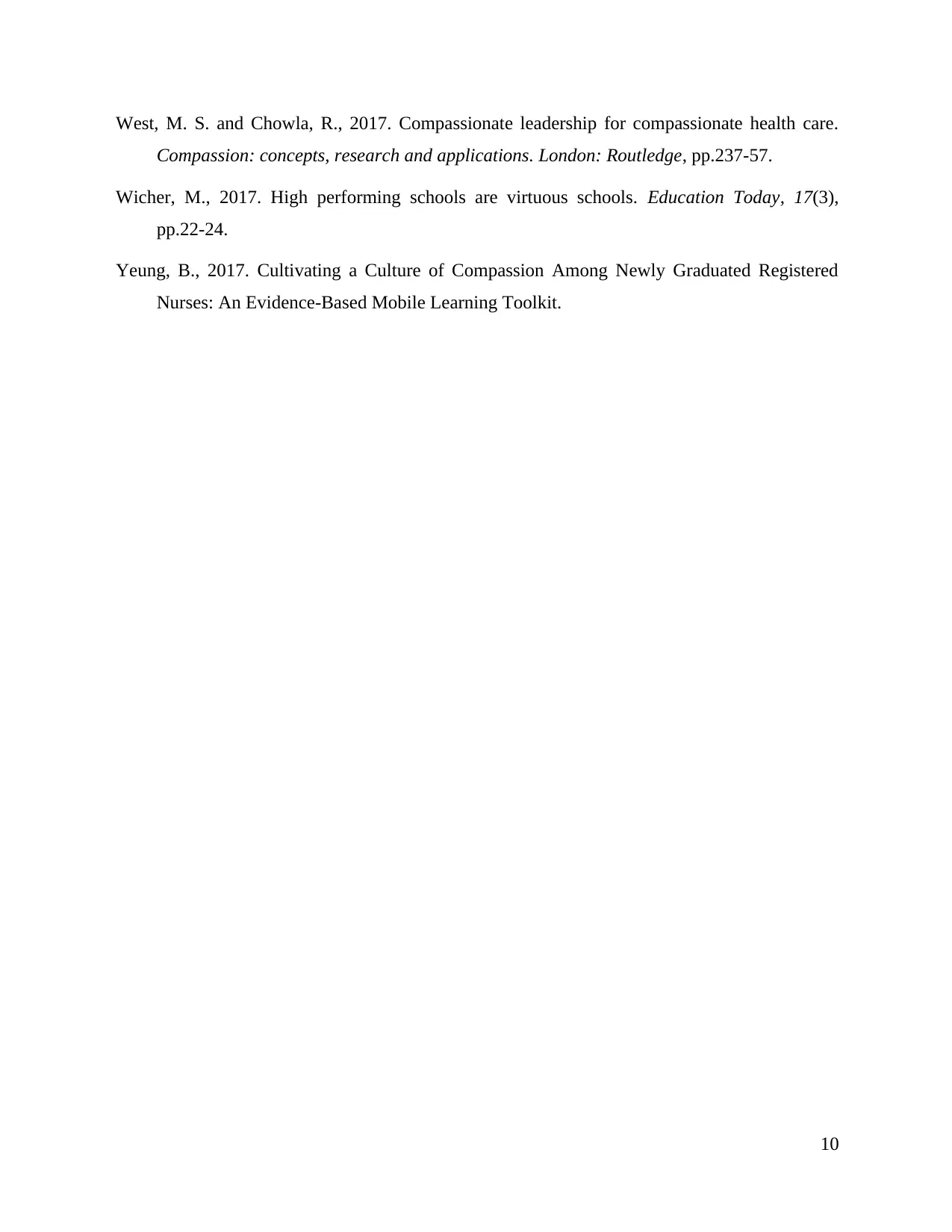
West, M. S. and Chowla, R., 2017. Compassionate leadership for compassionate health care.
Compassion: concepts, research and applications. London: Routledge, pp.237-57.
Wicher, M., 2017. High performing schools are virtuous schools. Education Today, 17(3),
pp.22-24.
Yeung, B., 2017. Cultivating a Culture of Compassion Among Newly Graduated Registered
Nurses: An Evidence-Based Mobile Learning Toolkit.
10
Compassion: concepts, research and applications. London: Routledge, pp.237-57.
Wicher, M., 2017. High performing schools are virtuous schools. Education Today, 17(3),
pp.22-24.
Yeung, B., 2017. Cultivating a Culture of Compassion Among Newly Graduated Registered
Nurses: An Evidence-Based Mobile Learning Toolkit.
10
⊘ This is a preview!⊘
Do you want full access?
Subscribe today to unlock all pages.

Trusted by 1+ million students worldwide
1 out of 12
Related Documents
Your All-in-One AI-Powered Toolkit for Academic Success.
+13062052269
info@desklib.com
Available 24*7 on WhatsApp / Email
![[object Object]](/_next/static/media/star-bottom.7253800d.svg)
Unlock your academic potential
Copyright © 2020–2025 A2Z Services. All Rights Reserved. Developed and managed by ZUCOL.





